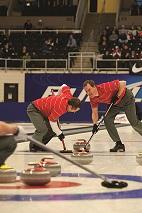
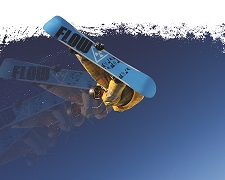
While elite athletes and world-class competitions were earning the kind of high-profile coverage they only receive every four years, participation at all levels of winter sports continues to drive cities in the Snowbelt and other states to host a variety of activities — from up-and-coming freeskiing and synchronized skating to traditional curling and pond hockey.
“Every weekend throughout the winter, we have some sporting event going on,” says James McKenna, CEO and president of the Lake Placid Convention and Visitors Bureau/Regional Office of Sustainable Tourism. That small village in upstate New York hosted the 1980 Winter Olympics and then never stopped welcoming snow and ice events, including Sochi-qualifying competitions. “The same names we’ll be seeing at the Games in Russia will be competing here first,” McKenna adds.
By contrast, you won’t recognize most of the participants’ names in February’s 34- and 31-mile American Birkebeiner, North America’s largest cross-country skiing marathon that stretches from Cable to Hayward, Wisconsin, — unless those names belong to your friends. Says Dawn Zanoni, sports marketing manager for the Wisconsin Department of Tourism, “The overwhelming majority of events Wisconsin has to offer do not cater to elite athletes.”
Olympic Fever
Two of the hottest winter sports spots in late 2013 and early 2014, however, did indeed cater to elite athletes. New York’s Lake Placid and Park City, Utah, are home to approximately 2,500 and 7,800 residents, respectively. Sports event planners and venue operators in both communities have worked long and hard to build an enviable Olympic legacy, one in which host facilities that were so central to the Games’ past successes continue to thrive today.
Lake Placid’s Olympic history goes all the way back to the 1932 Winter Olympics, but most people remember the village for 1980’s “Miracle on Ice,” when the U.S. men’s hockey team beat Russia at the beginning of the Cold War’s final decade.
“Here we are, 34 years later, and we’re still having competitions at our original venues on a regular basis,” says McKenna, who sold Olympics souvenirs in the village during the 1980 Games. “The venues have been updated, but Herb Brooks Arena still has that old ceiling you saw on TV. The Olympic spirit is part of the fabric here.”
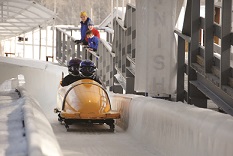
“If something happened in Sochi, we could host the Games,” McKenna boldly states, suggesting just how serious Lake Placid takes its commitment to ensuring sustainability of those original venues. “Magic still resides in that ice arena.”
Park City, located 30 miles southeast of Salt Lake City (official host of the 2002 Winter Games) were home to bobsled, skeleton, luge, ski jumping and Nordic combined events at Utah Olympic Park 12 years ago. The 389-acre venue remains active today, serving as a year-round training center and site of multiple Olympic qualifying events. Boasting three ski resorts within a five-minute drive of each other, the city also hosts many local and regional snowboard and ski events, including the 2014 NCAA Skiing Championships at Park City Mountain Resort in March.
In 2009, the Park City-based United States Ski and Snowboard Association opened the Center of Excellence, a high-end facility designed to serve today’s athletes by providing world-class training designed to strengthen the development of future Olympic skiers and snowboarders.
“We’re excited about all of the things that are happening, as far as Olympic venues and athletes,” says Bob Kollar, director of special events for the Park City Chamber/Convention & Visitors Bureau. “We’re proud that our Olympic legacy is alive and well. And that’s not by accident.”
Colorado Springs, USA
Nor is it by accident that Colorado Springs, Colorado, is home to more than 20 national governing bodies — including US Figure Skating and USA Hockey — plus approximately 60 sports organizations. Credit their presence to the United States Olympic Committee moving its headquarters to the city from New York in 1978.
“The Olympic presence really provides a spotlight for our community,” says Chelsy Murphy, director of communications for the Colorado Springs Convention & Visitors Bureau. “And it’s a great place to train.”
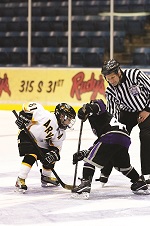
Ice sports are crucial to Colorado Springs’ winter events schedule because, as Murphy admits, the city doesn’t receive much snow on an annual basis. “I think people tend to associate Colorado with being covered in snow,” she says. “But we’re in the middle of the state, with mild winters. Any snow we receive melts quickly.”
Skate of the Industry
Colorado Springs also has been chosen to host the 2014 U.S. Synchronized Skating Championships, at the Broadmoor Skating Club. The roots of that sport, which involves teams of up to 20 (usually female) skaters moving in unison, reaches back to the Fifties but underwent dramatic growth during the past decade, according to Bob Dunlop, senior director of events for US Figure Skating.
Held between January and March during figure skating’s offseason, synchronized skating “is, in some ways, on par with figure skating,” Dunlop says, adding that the sport’s increased popularity means more opportunities for cities looking to host skating events. “Synchro is an emerging discipline that didn’t exist on anyone’s radar in terms of hosting until the early 2000s,” he explains. “And we’ve been in a very good situation in recent years with the sustained interest from communities in hosting figure skating events.”
Figure skating, by the way, is celebrating the 100-year anniversary of the U.S. Championships in 2014. This year’s event is slated for Boston’s TD Garden from Jan. 5 to 12.
Snow Business
Snowboarding has a much shorter history than figure skating. Making its debut at the Winter Olympics in Nagano, Japan, in 1998, the sport has been overshadowed in recent years by freeskiing. More often viewed as a separate sport rather than a subset of freestyle skiing, freeskiing involves tricks, jumps and terrain park features such as rails, boxes, jibs and other obstacles. As a result, many ski resorts have built terrain parks to accommodate increased demand among event planners and participants of varying skill levels.
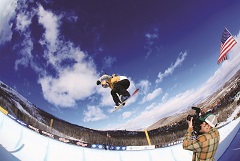
“Freeskiing has grown very significantly in the past three to four years,” says Tom Kelly, vice president of communications for the USSA, adding that the construction of terrain parks at ski resorts has impacted snowboarding’s participation numbers.
The ski and snowboard industry faces other challenges, too. “One of the things that’s always been a bit awkward for us is that we don’t fall into the same mold as swimming or cycling,” Kelly says, referring to the fact that most sanctioned ski and snowboard competitions must be hosted at ski resorts. “These events are extremely venue-intensive and often involve snowmaking and new construction, and they can be cost-prohibitive.”
The Frozen Chosen
The cost factor likely is one significant reason why not every winter-sports destination seeks to host elite — or even mainstream — events.
Take Wisconsin. In addition to the world-famous American Birkebeiner (which doesn’t discriminate based on skill), Eagle River puts on World Championship Snowmobile Derby Week every January. Elite riders are showcased, but there are opportunities for recreational enthusiasts, too. Then, in February, comes the Labatt Blue USA Adult Pond Hockey Championships, also held in Eagle River.
“Pond hockey is growing phenomenally,” Zanoni says. “You’ll see rink after rink after rink on those lakes up in northern Wisconsin.”
Hockey, along with figure skating, remains the focal point across the border in Bloomington, Minnesota, too. In fact, mention winter sports to Todd Lehrke, associate director of sports development for the Bloomington Convention & Visitors Bureau, and he’ll tell you that ice is the first thing that comes to his mind.
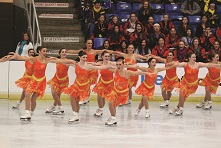
The city also will welcome the inaugural Amateur Athletic Union’s Mite and Squirt National Ice Hockey Tournament in early March, which will run concurrent with both the Minnesota State High School League boys’ and girls’ ice hockey championships and the Let’s Play Hockey Expo, billed as the largest consumer hockey exposition in the world.
Another ice sport that often gets overlooked, even with increased television coverage, is curling. But the Fargo-Moorhead Athletic Commission, the sports arm of the Fargo-Moorhead Convention and Visitors Bureau that serves the North Dakota-Minnesota border communities, hopes that won’t always be the case.
In November, Fargo’s Scheels Arena played host to the 2014 U.S. Olympic Curling Trials, and is bidding on future World Curling Championships and USA Broomball National Championships, according to Steve Saxlund, the commission’s director of sports. Between Fargo and Moorhead, no fewer than 14 ice sheets — with potentially more on the way — are available for events.
In the past, the area has welcomed the International Ice Hockey Federation World Championships and in February, Fargo Youth Hockey will host the largest Squirt international hockey league tournament, bringing in an estimated 130 teams.
“We really thrive on these annual youth hockey events,” Saxlund says. “We could bring in no international events and still be busy.”

